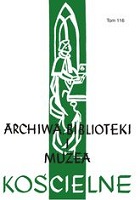THE VICISSITUDES OF ST PETER AND PAUL’S CHURCH IN BYCHAWA AT THE TURN OF THE 16TH AND 17TH CENTURIES BASED ON CHURCH SOURCES
THE VICISSITUDES OF ST PETER AND PAUL’S CHURCH IN BYCHAWA AT THE TURN OF THE 16TH AND 17TH CENTURIES BASED ON CHURCH SOURCES
Author(s): Włodzimierz BielakSubject(s): Christian Theology and Religion, History of Church(es), Social history, 16th Century, 17th Century
Published by: Katolicki Uniwersytet Lubelski Jana Pawła II - Wydział Teologii
Keywords: Bychawa; Myszkowski Family; Mikołaj Pilecki; Andrzej Myszkowski; Stanisław Myszkowski; Joachim of Borzęcin;
Summary/Abstract: This article aimed to correct erroneous or imprecise information about the parish in Bychawa, present in the literature on the subject so far, which is, nota bene, not very extensive. The discussions in this article, based mainly on church sources (which have not been often used so far by others), enabled the Author to shed new light, at least in part, on the time of individual stages in the history of the Bychawa church at the turn of the 16th and 17th centuries. The Calvinist movement must have begun in the last years of the fifteenth decade of the sixteenth century and is related to the activities of Mikołaj Pilecki. Andrzej Myszkowski strengthened the Protestant milieu here in the early 1650s, establishing a Calvinist school and perhaps bringing in permanent Calvinist ministers. It is incorrect, however, to link the origins of Calvinism in Bychawa only to Andrzej Myszkowski. The repossession of the church in Bychawa was related to Stanisław Myszkowski, the Lublin deputy cup-bearer, son of Andrzej. After the divisions in the Calvinist movement and the weakening of their community in Bychawa, he turned his attention to the old faith, as did other magnates of that period, and probably brought a Catholic priest around 1582. The church was also returned to the Catholics, which enabled the archdeacon of Lublin to make the first visitation after the Calvinist times in 1595. The building, however, was largely ruined. Attempts were made to maintain it until the 1620s by making the necessary repairs. The construction of a new masonry church probably began in the mid-1620s, when the parish priest, Sebastian Piątkowski, won the lawsuit over the church property with Zofia Wierzbicka. Shifting the date of the church construction to an earlier period is not well-founded. St. John the Baptist’s church has survived to our times and still serves the Catholic community of Bychawa.
Journal: Archiwa, Biblioteki i Muzea Kościelne
- Issue Year: 2021
- Issue No: 116
- Page Range: 5-14
- Page Count: 10
- Language: English

